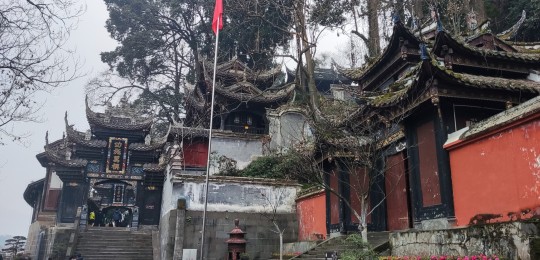#Dujiangyan
Text
The 2,000-year-old Dujiangyan dam is an engineering marvel of the ancient world. Watch the spectacular water releasing festival to honor this magnificent construction.
#Engineering#dam#water#Li Bing#Qin Dynasty#Min River#Dujiangyan#festival#China#ancient#history#ancient origins
23 notes
·
View notes
Text
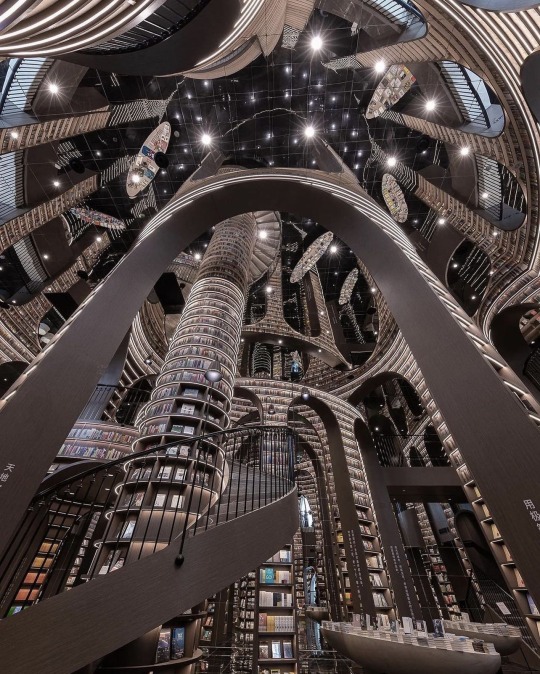




Dujiangyan Zhongshuge is a bookstore located in Chengdu, China. Designed by architecture firm X+Living
10K notes
·
View notes
Text

82 notes
·
View notes
Text

Zhongshuge Bookstore in Dujiangyan, China
5 notes
·
View notes
Text
Mesmerizing Bookstore Feels Like Walking Into an Escher Drawing
There’s a bookshop, with narrow shelves crammed with books, the smell of dust and paper in the air. And then there’s a book buying experience, where the shop itself is the attraction.
The mesmerizing Dujiangyan Zhongshuge bookstore in China, is clearly the latter, with an interior that almost defies explanation or description. We’re positive that photos don’t do the experience justice,…

View On WordPress
1 note
·
View note
Photo
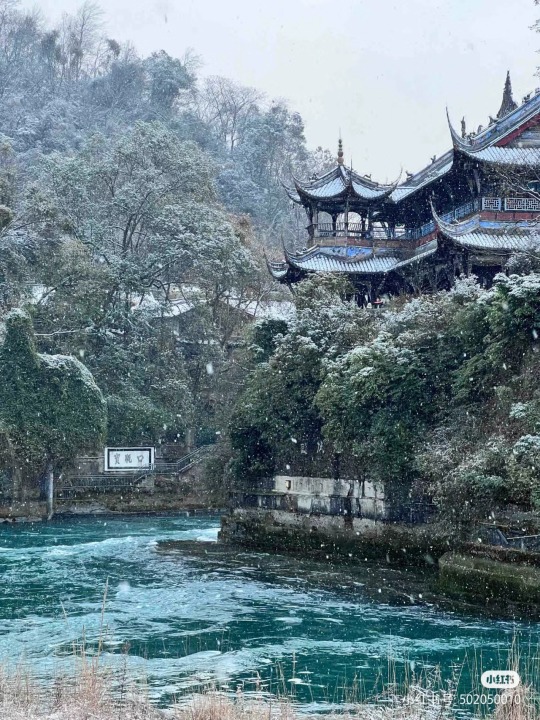
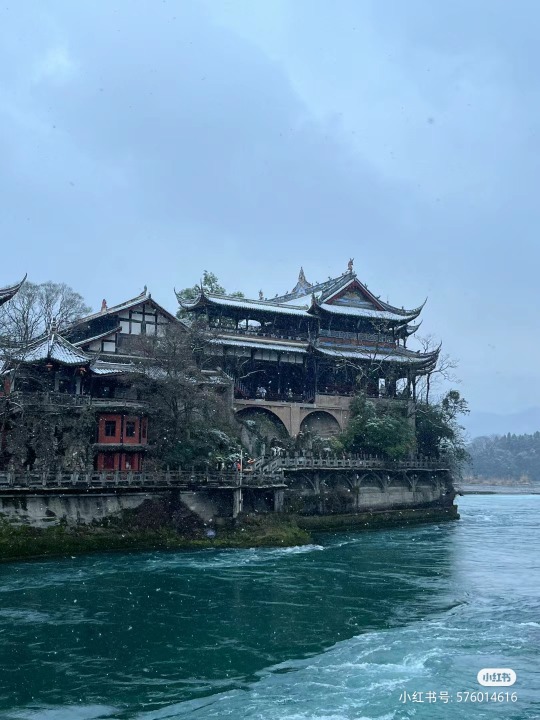





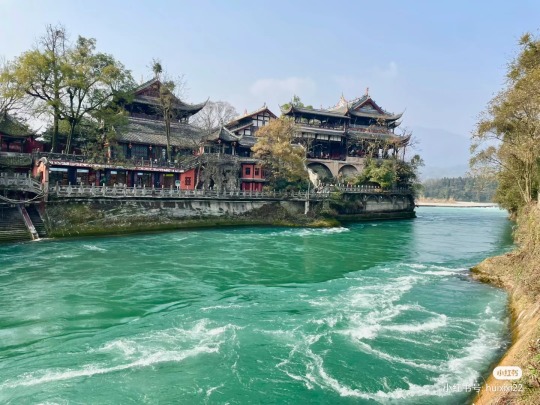
dujiangyan都江堰, sichuan
2K notes
·
View notes
Text




Dujiangyan Zhongshuge bookstore l China
976 notes
·
View notes
Note
hi! sorry if this is outside your wheelhouse, but i was doing some googling surrounding chinese dragons and their pearls and i stumbled upon a few stories about a boy who turned into a dragon after swallowing a magic pearl. some of these sites say that this is a well known legend but when i asked my mom (grew up in rural china) she says she's never heard of any such stories. maybe it's because of my phrasing when i asked her (my chinese isn't the best) but i also can't seem to find any reputable sources/sources for this story that aren't white, which is strange if this story is so truly "well known".
i guess my question is: have you heard of this story before? is this an actual chinese legend? and if so, do you have any sites where i can read up more on it (english/chinese sites both work). thank you!
I have never heard of this story personally, but assuming you're talking about "the Dragon Pearl", it appears that this story is a translation of 望娘滩, which is a folk legend mostly popular in Sichuan province's Dujiangyan area, and is also a Sichuan opera featuring bianlian.
youtube
That could be why your mom doesn't know about it. There are so many regional folk stories.
古老的感人民间传说《望娘滩》
#text#answered ask#chinese opera#chinese folklore#'well known' < they'll say that about anything lol
146 notes
·
View notes
Text



A bookstore full of vitality and undulating forms in Dujiangyan, a city with more than a thousand years of history located in southwestern China. The project is signed by the X+Living architecture studio, creating an innovative cultural paradise, where you can immerse yourself in books and reading.
#culture#books#books libraries#literature#book#books and libraries#books & libraries#booklover#words
610 notes
·
View notes
Text
Into the Erlang-verse: Li, Zhao, Yang
-This is something I wrote for fun and reference purposes, back when I was starting to seriously get into Chinese mythology. As such, there is no citations, and is meant to be more of a general introduction to Erlang Shen in pre-modern writings.
(Emphasis on "pre-modern", because, as much as I love the Lotus Lantern + Prequel TV series, it's just a little frustrating to see people taking the shows' version as the end-all-be-all of such a complicated deity, y'know?)
-Anyways, much like Nezha, his Archery Accident Bro, Erlang has what I'd refer to as his "Pop Culture Form": Handsome three-eyed warrior god wielding a three-pronged spear, accompanied by his doggo Xiaotian Quan(Literally "Skyhowler"), going by the surname "Yang", jade emperor's nephew, etc.
-However, The Second Lad is an even messier amalgamation of deities worshiped in different parts of China, even in his supposed "home domain", Sichuan. Here, I'm only gonna talk about the most well-known and significant Erlangs.
(Not even gonna go into the possible Zoroastrian influences and the Dujian thing...)
1. Lord of Sichuan, "Li Erlang"
Key words: Hydraulic engineer, based on a historical official and his son, fierce competitor with Zhao Erlang for the Lord of Sichuan title
Weapons: Knowledge
Power: Can turn into a bull/dragon
Pets: N/A
"Who's Yang Jian? I've been watching over Sichuan since the Qin dynasty."
Li Bing was a pretty typical case of famous historical figure being worshiped as gods posthumously; born in the Warring States era, this official was put in charge of the Shu Prefecture (modern Chengdu) by King Zhao of Qin, and he was known as the creator of Dujiang Yan, an ancient irrigation + flood control project.

Later Tang legends deified him with a bunch of traditional "Flood-control hero" tropes taken from Yu the Great (heads up JTTW readers, SWK's staff is originally his extendable ruler), mostly the "hero turn into a giant animal" and "fight and subdue local water demons" aspect.
Though he wasn't yet known as an Erlang, or gained a son called Erlang as later folklore would have it, Li Bing's worship began in the Eastern Han dynasty, and he had a long tradition as Sichuan's guardian deity.
Even as later versions of Erlang began to populate, in the Qing dynasty, people of the province were still like "Our Lord of Sichuan is Li Bing/Li Erlang, not Yang Jian, as the novels would have you believe!"
What made Li Bing and his likely nonexistent son into "Li Erlang" could be traced to the two "warlord states" that occupied Sichuan after the fall of Tang dynasty: both states tried to use the Lord of Sichuan worship to strengthen their own legitimacy, and passed decrees that 1) said Erlang was Li Bing's son and 2) granted both father and son honorable titles, as mentioned in Song dynasty records.
However, due to the association of Erlang with previous warlord states, the first emperor of Song had reassigned Li Bing a lesser title and taken away his son's title altogether, reducing him to just "God of Guankou", and worshippers were quite disgruntled by the change; there was even a rebellion using the Guankou worship rituals to legitimize itself, a decade after said emperor's death.
Fun fact: when I went to the Two Lord’s Temple (of Li Bing and Li Erlang) in Dujiangyan, even though the god worshipped in the main hall was supposed to be Li Erlang, the plaque next to it still said something like "Li Erlang, also known as Yang Jian"...
Which really shows just how influential FSYY is on popular worship, to the point of overshadowing older incarnations of certain deities.
2. Immortal Master of Illustrious Sagacity, "Zhao Erlang"
Key words: Chief of Jiazhou Prefecture, dragon slayer, No.2 violator of archery safety (first place goes to Nezha)
Weapons: A scribing tablet, slingshot, sword, bow and arrows
Power: Supernatural strength, monstrous giant form
Pets: unnamed white horse, hunting hawks and hounds
"C'mon, my aim isn't that bad! What happened in the Zaju was a one-time thing!"
The prototypical Taoist Erlang, his name, "Zhao Yu"(赵昱) first appeared in a Song dynasty source. At this point, the story of Erlang was mainly defined by two traits: 1) was, or was related to an official in charge of Sichuan in bygone times and 2) Did heroic flood control stuff, probably through dragon-slaying.
One notable strand of local worship was the "God of Guankou"; historical records mentioned that people sacrificed hundreds and hundreds of goats to him, as well as a regional festival in Sichuan where people played out his confrontation with dragons. It coexisted and entwined with the "Lord of Sichuan" worship, until the Song dynasty.
In typical Song dynasty fashion, the officials decided to give their own official title to this...Erlang/Lord of Sichuan/God of Guankou guy, bringing our titular "Zhao Erlang" into existence.
Also a deified official from the Tang dynasty, his image was more heavily influenced by Taoism (historically popular in Sichuan) and centered around one of its holy places, Mt. Qingcheng, which just happened to be quite close to Dujiang Yan.
Though in the Northern Song dynasty, the state-recognized Erlang was still "Li Erlang", the Taoist Zhao Erlang had proven himself to be a strong competitor by the Southern Song and Yuan dynasty, thanks to a massive amount of opera plays.
First we have SJSSDQ (三教搜神大全, Yuan Dynasty), an encyclopedia of Buddhist, Taoist and Confucian gods, where his traditional backstory as an ascended mortal official was combined with the dragon-slaying feat to nudge Erlang toward a more warrior-esque image, a hunting god who appeared on a white horse with his entourage of hunters.

-We also got the first mention of what would become his six/seven sworn brothers; the "Seven Sages" who jumped into the water to assist him in the dragon fight.
Then we have two Yuan-Ming Zaju plays, "Erlang of Guankou Slays the Jian-jiao"(灌口二郎斩健蛟) and "Erlang Drunkenly Shot the Demon-locking Mirror" (二郎神醉射锁魔镜), in which many traits associated with JTTW's Yang Erlang could already be seen: first, his three-pronged weapon, seven brothers and bow/arrows, second, the naming of his brothers as the "Seven Sages of Mt. Mei" and his ability to shift into a "true form", aka the monstrous giant form he used in JTTW.
(The plot of the second Zaju is exactly like it sounds: Erlang and Nezha had a drunken archery competition, accidentally broke the Demon-locking Mirror and released the Bull Demon King + Hundred-Eyed Demon, and spent the rest of the play doing damage control.)
3. The Little Sage, "Yang Erlang" (JTTW)
Key words: Jade Emperor's nephew, cleaver of Peach Mountain, SWK's true equal in battle
Weapons: Three-pronged, Double-bladed Spear, slingshot, bow and arrows, axe
Power: transformations, Cosmic Body, divine sight/Phoenix Eye(?)
Pets: a celestial Xiquan, literally "Thin Dog"
"First time we met, and that monkey made fun of my origins as a conversation opener. Could you believe it."
The Man, The Myth, The Legend! As I said before, a lot of his traits were inherited from "Zhao Erlang", including his Taoist title, his temple at Guankou, etc.
However, Erlang being Jade Emperor's nephew seemed to be mostly popularized by JTTW: the only other work that might have given Erlang this backstory was The Precious Scroll of Erlang, previously dated to the 1560s, though a Chinese paper published in 2018 proposed a later creation date (1620s).

Much like JTTW Nezha, his backstory was somewhat barebones: we knew from SWK's taunt that his mother was the Jade Emperor's sister, who got chummy with Yang the mortal, gave birth to him, and was presumably locked under the Peach Mountain for that, bc Erlang then rescued her by cleaving it in half with an ax.
(Sounds familiar? The same backstory would later be copied over to Erlang's nephew, in the Lotus Lantern legends)
His other notable feats include falling 2 phoenix with his slingshot, as well as slaying the "Seven Demons of Mt. Mei ''. Out of pride, he chose to remain in Guankou instead of associating with his heavenly relatives, and did not answer to general summons to court from the Jade Emperor, only taking special assignments (听调不听宣).
Apart from his famous fight with SWK, Erlang also appeared in JTTW chapter 63, where, together with his sworn brothers, he helped the pilgrims fight the Nine-Headed Wyrm, son-in-law of Bibo Lake's dragon king. His dog continues to be the MVP in this fight, biting off one of the demon's heads, leaving it wounded and fleeing toward the north sea.
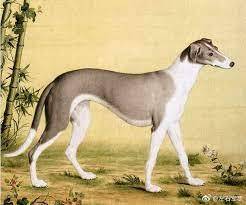
Though the description of his battle with SWK implied that he did have some sort of supernatural sight, at this point in time (Ming dynasty), Erlang wasn't yet depicted with a third eye in artworks and literature.
There are a small amount of evidence that suggest the third eye thing might have shown up in statues of this period, though.

4. Master of the Ninefold Mystic Way, "Yang Jian" (FSYY)
Key words: Disciple of the Taoist sage Yuding, veteran of the Investiture War, Nezha's comrade-in-arms
Weapons: Three-pronged Spear, slingshot
Power: Ninefold Mystic Way, 72 transformations, invulnerable to physical attacks, Samadhi Fire (in FSYY it's on the same level as a D&D wizard's Fireball spell)
Pets: Howling Celestial Dog, unnamed white horse
"I fought a transforming monkey demon too!"
Fun fact: the guy whose name was most often taken as Erlang's "real name" by pop culture was never actually referred to as "Erlang" in his debut novel. Could ya believe it.
Quick, dirty summary of FSYY: kinda like the Chinese Iliad, about the overthrowing of Shang dynasty and its tyrannical King Zhou by King Wu of Zhou, with a dash of Taoist infightings, and almost everyone who died in the fight got revived as gods and became part of the celestial bureaucracy, thus "Investiture of the Gods".
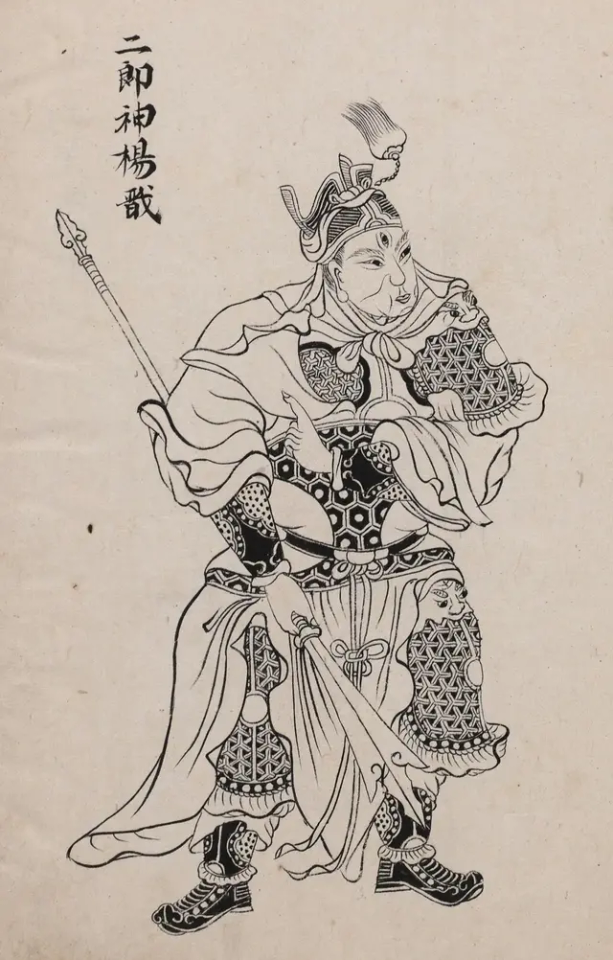
Under the order of his master, the Taoist sage Yuding (literally "jade tripod"), Yang Jian makes his first cameo in chapter 40 to assist his senior, Jiang Ziya, in the fight against the Four Generals of Clan Mo.
A master in the arts of the Ninefold Mystic Way and 72 transformations, he has the same divine title as Zhao Erlang and is considered "A Sage in Flesh" after the end of FSYY.
As such, he's able to survive getting eaten by a monstrous weasel, a metal whip in the forehead, graphic disembowelment, etc. and used his transformation skills for some SWK-style "beating people up from inside their stomachs".
On one very notable occasion, he transformed into a beautiful palace consort to dupe Tu Xingsun ("Earth-traveling Son") and capture him.
Oh, and also, on his way to get Tu Xingsun's master, he ran into this random demon in a lake, who led him into a cave. After he got inside, the demon just disappeared, leaving him with the Three-pronged Two-bladed Spear, as well as some nice bling.
Then two kids burst in, accused him of stealing the bling, and...instantly became his students after learning his name? Yeah that was a weird sidequest.
However, Yang Jian's most iconic battle is probably his fight with Yuan Hong, the White Ape of Plum Mountain...who also practiced the Ninefold Mystics, used an iron cudgel, and were sworn brothers with six/seven demon kings.
Only with the help of Nvwa's magical painting, the Shanhe Sheji Scroll, was Yang Jian able to capture the ape, and subsequently, let Jiang Ziya decapitate him with Sage Luya's Immortal Slaying Flying Knife.
When the Three Demonesses were caught and executed at the end of the book, he was the one responsible for slaying the Nine-headed Pheasant Demoness, which is a neat parallel with JTTW.
His Howling Celestial Dog appears in chapter 47, and is even more of an MVP in fights: 12 immortals and demons have been bitten by this dog, which was "as large as a white elephant and as swift as an owl".
Funnily enough, every time Yang Jian summoned his hound, it is described in the same way as, say, other immortals may summon a flying sword, and my mental image is just him yeeting his giant monster dog at the enemy like you'd throw a Pokeball.
(A list of everyone Xiaotian had bitten in FSYY: Zhao Gongming, his sister Bixiao, Xinhuan, Deng Chanyu, Zhou Xin, Hua Huan, the Winged Immortal, Yuyan, Lv Yue, Yu Hualong, Dai Li the dog demon, the Nine-headed Pheasant Demon.)
Conclusion:
-The way I see it: Li is the Erlang of regional worship, Zhao is the Erlang of Zaju plays, and Yang is the Erlang of vernacular novels, who becomes super popular and overshadows his two predecessors.
-And Erlang's depiction in premodern Lotus Lantern tales is what we in the business call "a whole new can of worms". But that's a series for another day.
#erlang shen#chinese mythology#chinese folklore#journey to the west#investiture of the gods#fengshen yanyi#xiyouji#yang jian
15 notes
·
View notes
Text
There's no fucking way i'll have this go lost because of Twitter's downfall

"Design inspiration, symbolism and references behind the water beasts in New Gods: Nezha Reborn"
❗ Premise. DO NOT take what I write for absolute truth or canon material, regardless of the sources. I drew my own conclusions, heavily influenced by my own reading key. Take it as a theory!

The first creature coming to mind when looking at them is surely the Xièzhì (獬豸), a mythical beast that appears multiple times in East Asian legends. We can find a detailed description of these creatures in the Shou Pu (獸譜), a painted album created for the Qianlong Emperor from 1750 to 1761 by court artists Yu Sheng and Zhang Weibang, depicting terrestrial animals and legendary beasts and part of the Emperor's personal encyclopedia. Also known with the korean name "Haetae", the Xiezhi is depicted as a muscular beast with a likeness to a lion, goat, and unicorn (sometimes referred to exactly as a “unicorn lion”) living in the northeastern wilderness.
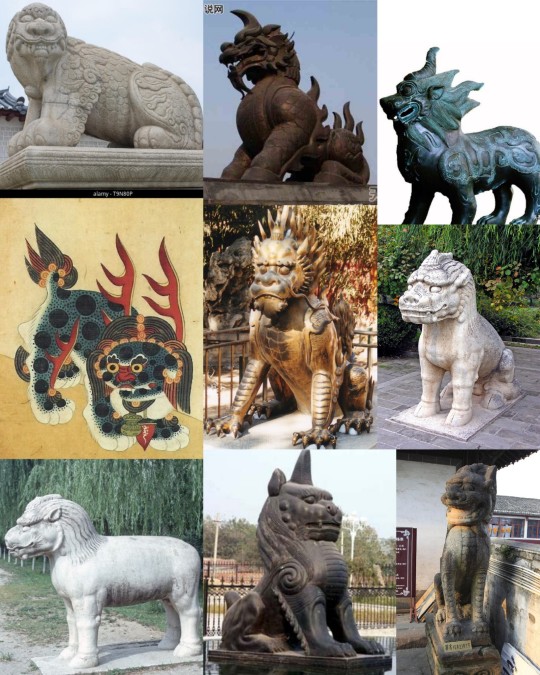
In Shou Pu, and also in many legends, it's said they're naturally able to distinguish innocent from guilty, right from wrong, making them an ultimate symbol of justice that appears a lot in decorations, paintings, buldings and clothing, giving also the name to the judicial hat (法冠) that symbolizes the impartial and effective enforcement of the law.
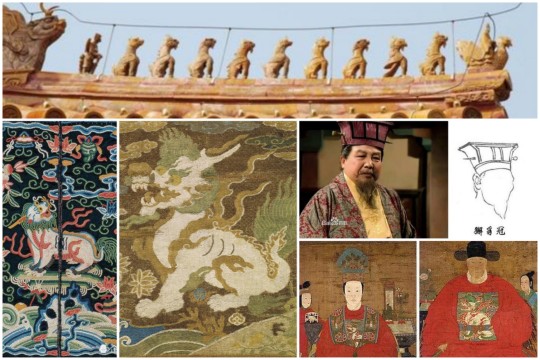
It's also known as a guardian against disaster, a symbol of water due to its fire-eating qualities and a messenger of the heaven, which also stands for a sense of justice. The attention on justice's symbolism is also drawn by another design detail of the water beasts: the third eye on their forehead. Comes natural the association with “the Eye of Heaven” (天眼), able to differentiate truth from lies, and with "the embodiment of justice" himself: the noble and powerful warrior god Erlang Shen, who is also related to hydrology in a very interesting way.
Now stay with me, because this will lead to another creature that also possibly inspired the water beasts and that brings EVERYTHING together: justice, water and floods. But to better introduce them, first we have to understand why the reference to Erlang is important.
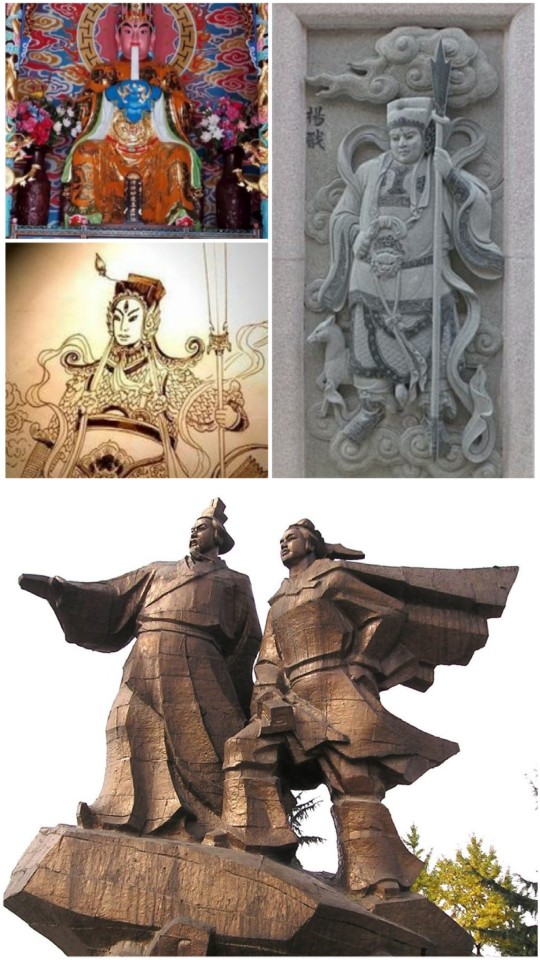
In Chinese myths, Erlang Shen is also a folk hero that helped alleviate the terrible flooding of the Min river. With his name meaning "godly second son" (er = two; lang = boy; shen = god), he was believed to be the second son of the engineer Li Bing, hired to prevent the yearly flooding that would affect the lives of the people of the Chengdu Plains and Dujiangyan city (Sichuan). However, Li Bing couldn't discover the source of the flooding, as it appeared that the flooding wasn't natural. Legend has it that Li Bing sent Erlang to sail up and down the river for a year to attempt to discover the source of the annual flood, but he couldn't discover the cause either.
One day, as Erlang is walking with seven hunters who had witnessed his bravery in slaying a rogue tiger, they chance upon an old woman who is crying at the edge of the river near Dujiangyan. She tells Erlang that she is distraught, as one of her grandsons is to be sacrificed to a dragon that has held dominion over the river for generations. Believing that he has discovered the source of the river’s flooding, Erlang volunteered to take the place of the woman’s grandson to be offered as sacrifice to the dragon instead.
When the ancient dragon arrived to take his sacrifice, Erlang and his friends leapt from hiding and chased the dragon to the river, where the old woman trapped it with chains in a pool below the Dragon Taming Temple.

With the dragon immobile, Erlang splitted the creature in half with his double-edged lance. And with the dragon dead, the annual flooding ended and peace and tranquility came to the Chengdu Plains. To thank Erlang for his bravery, the people elevated him and his father to godhood and dedicated a local temple as Two Kings Temple in their honor (The Erwang Temple in Dujiangyan).
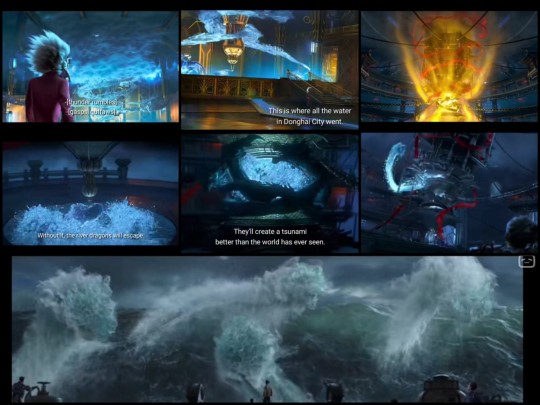
The myth of the water dragon being chained to control the hydrology of the province instantly felt familiar. And it's here that we find the connection to the water beasts.
Li Bing and his son Erlang worked at the complex irrigation system that protected the area and the people from the severe flood of the Min River: the Dujiangyan irrigation system, constructed in 256 BC, which is still in use today. In literature's classic "Huayang Guozhi·Shuzhi" is recorded that, along other clever solutions to avoid a dam, Li Bing also created 5 massive statues referred to as "Water town god beast" (鎮水神獸 if the translation is wrong please correct me!) which resembled a single horned creature similar to a rhino. With a length of more than 3m and a weight of 8 tons, two of these statues were buried in the river to "tame the water spirits". The resemblance with the water beasts, able to trap the river dragons, is astonishing. Curiously, when in July 2013 one of these statues was brought to the surface by archaeologists, heavy rainfalls occurred in Sichuan causing successive floods, and rumors spread saying "that removing the beast from its place, the water spirits couldn't be trapped anymore", followed by the request to put it back in its place claiming their ancestors "buried it there for a reason". According to a popular local tradition, rhinos are a divine beast that can help stop flooding and the newfound statues were supposedly buried by a local folk hero, more likely Erlang himself.

Back to Nezha Reborn, even if Donghai is a fictional city with the name of the raging sea where Nezha kills Ao Bing, it's located near the Eastern Sea. According to what Ao Guang says, is VERY likely that most of the water drawn in by the beasts is from the Yangtze river and its tributary the Min river itself, which would make everything coherent.
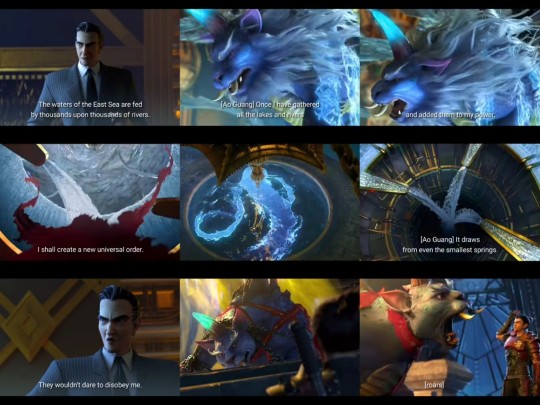
In addition to the justice symbolism of the water beasts (and this is my personal interpretation), Ao Guang's control of the waters (and, as a result, of Donghai itself) can also be represented by the chained water beasts themselves, being them the associated with a benevolent and righteous ruler. Therefore, the ending scene with Su Junzhu carrying the beast cub, can be read as justice finally being brought in Donghai following Ao Guang's demise, as the comeback of water finally marks the city's rebirth.

📚 References:
-Qianlong's encyclopedias, republished as "Natural History in the Palace Museum" by the Palace Museum Press and CITIC Press in Beijing
-A Study of Criminal Proceeding Conventions in Tang Dynasty, Xi Chen
-Lunheng 論衡, Wang Chong -Collier I. D. Chinese Mythology
-The Chronicles of Huayang (Huayang Guo Zhi 华阳国志)
-The Collection of Imperial Books of Ancient and Modern Times (Qing Dynasty) Jiang Tingxi, Chen Menglei, etc.
-Probably more I forgot to take note of 🧍
#nezha reborn#nezha#new gods#new gods nezha reborn#chinese mythology#mythological creature#chinese legend#erlang shen#ao guang#ENJOY THIS 6H WORTH OF RESEARCH BECAUSE SOMEONE ASKED WHAT KIND OF CREATURE THE WATER KITTY WAS#I hyperfocused on this so bad#I don't regret it tho#Water kitty go brrr#movie theory#Appreciate my effort for translating from chinese#Which is absolutely NOT a language i know even in the slightest#MothTalks
110 notes
·
View notes
Note
The dujiangyan zhongshuge bookstore in China is on my bucket list.

OMG, I would just expire from mental and visual overload!
26 notes
·
View notes
Text

La libreria-labirinto, Dujiangyan (Cina), che ricorda le opere di Escher, è stata realizzata dagli architetti dello studio X+Living di Shanghai.
Lo studio che ha realizzato l’edificio ha preso ispirazione dal paesaggio della zona: il sistema di irrigazione del Dujiangyan, costruito attorno al 250 a.C. e oggi nell’elenco dei patrimoni dell’UNESCO, devia parte dell’acqua del fiume Min in un acquedotto che si dirige verso Chengdu, modificando il territorio a seconda delle necessità.
Nel reparto di letteratura centrale, i designer hanno utilizzato il soffitto a specchio per espandere visivamente la duttilità spaziale e creare un’atmosfera aperta e alta.
I corridoi e i passaggi tra una stanza e l’altra sembrano riprodurre questo sistema antichissimo di canali. La struttura delle colonne piene di libri riprende le foreste in bambù, così come il pavimento nero specchiato ricorda il letto del fiume Min e le panche in legno nei corridoi e nelle sale richiamano le tipiche imbarcazioni che navigano lungo il corso d’acqua.
By living corriere it architettura libreria-x-living
6 notes
·
View notes
Video
都江堰dujiangyan in winter, sichuan
1K notes
·
View notes

